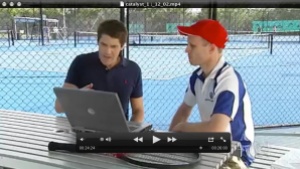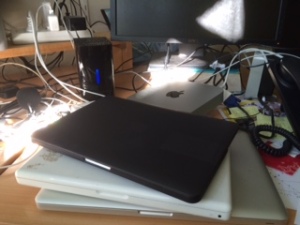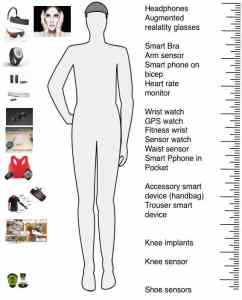 In case you were wondering about the potential for your fitness tracker and big brother…its already arrived!
In case you were wondering about the potential for your fitness tracker and big brother…its already arrived!
The idea of quantification of an athletes movement is something we have been using at the elite end of the spectrum for over a decade to help improve performance and reduce injury. With the popularisation of the technology in mass market, consumer devices like (shameless plug alert) the excellent Jaybird REIGN the potential for the weekend warrior to improve their fitness and health is clear. Whats the next step, our work in big data and analytics tells us its the large scale aggregation of data from large populations. Here long term health and well being can be tracked and used by the err… forces for good!
But what’s around the corner? Well my MBA program director (yes I’ve been hitting the books as a student) produced a graphic novela on a distopian reality where everything is a metric and is up for sale ( you might like to read it http://isthisokay.com )
In his subject last year I was invited to look at some future scenarios after doing some technology predictions in the wearable space. This is new stuff to crystal ball and the scenarios varied from personalised shopping and eating, where the shop keeper knew you were coming and what you would want to buy, as too the restauranteur knew your favourite meal, where you like to sit, and how many calories you needed that day etc.. I thought some of these were a bit far out, even though they were consistent with the emerging technology trends. However blow me down if in the coming weeks I found that some of Australia’s banks knew when high value customers walked in the door and offered a prestige service (and no bout sniffed a sales opportunity). See below for a link on emerging technologies in banking. So too high end restaurants had clubbed together to do customer profiling, gathering data such as who were good tippers! (See below for a link to a range of technologies)
Closer to home, well at home actually, it seems that Flybys ( a shopping card that earns rewards points, all the while collecting detailed information about your shopping habits) is now offering rewards points for using it, if you partner with….wait for it, your health fund. Bingo! here are your shopping habits and what you buy (I hope its healthy!) coupled to how much exercise you do being made available to your health fund. On the plus side there is perhaps an opportunity for a premium reduction, thats the carrot…wheres the stick!!
Of course if fitness trackers aren’t for you, fear not, your probably already being monitored by your smart phone (iOS and Android) and they capture about 70% of you daily activity
Yikes!! I’ve been sitting for 1/2 an hour, better rack up some steps
References
Is this OK? Prof Nick Barters Distopian reality of the future http://isthisokay.com
Resturant customer tracking services http://streetfightmag.com/2013/07/22/6-tools-restaurants-can-use-for-better-guest-intelligence/
Flybuys and Fitbit http://www.flybuys.com.au/partners/fitbit
Banking trends http://www.cio.com.au/article/547615/how_our_banks_innovating/
 Hardly a day goes by when mainstream (or alt) press, facebook or twitter doesn’t report some event, quote or photo that promotes feeling of outrage, sufficient to stir the emotions, galvanising us to share or retweet some sound bite, MEME image or story.
Hardly a day goes by when mainstream (or alt) press, facebook or twitter doesn’t report some event, quote or photo that promotes feeling of outrage, sufficient to stir the emotions, galvanising us to share or retweet some sound bite, MEME image or story.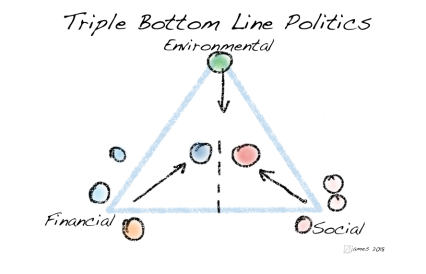 There is a real nice idea in accounting called the triple bottom line. The idea here is that you measure in three areas financial, social and environmental and try to achieve a good outcome for all three. Its a really nice idea and gets back to what ‘accounting’ is all about, that is to account for all things, whereas mostly its used as a bit of a dirty work because its most often associated with financial matters only.
There is a real nice idea in accounting called the triple bottom line. The idea here is that you measure in three areas financial, social and environmental and try to achieve a good outcome for all three. Its a really nice idea and gets back to what ‘accounting’ is all about, that is to account for all things, whereas mostly its used as a bit of a dirty work because its most often associated with financial matters only.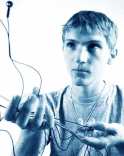 One of the great joys of being a researcher is taking on doctoral candidates. These are our brightest minds of the future who go on a 3yr (or more) journey into the unknown. Armed with years of technical training it’s their opportunity to apply it creatively to further advance knowledge and society. One of the great things is seeing that success carry forward, where ever their careers take them ..
One of the great joys of being a researcher is taking on doctoral candidates. These are our brightest minds of the future who go on a 3yr (or more) journey into the unknown. Armed with years of technical training it’s their opportunity to apply it creatively to further advance knowledge and society. One of the great things is seeing that success carry forward, where ever their careers take them ..
 At the most recent
At the most recent 